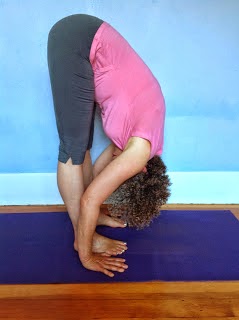by Baxter

We are often asked by someone if they should avoid certain movements in the joints when doing yoga poses, especially if that person has something going on a particular area. Perhaps the most common area that I get asked about is the movements of the spine (see All About the Spine: Anatomy and Movements for info on spinal movements) These include forward bending (known technically as flexion of the spine), back bending, (known technically as extension of the spine), twisting (known as rotation of the spine), and side-bending (often referred to as lateral side-bending of the spine). There are, of course, possible combinations of these movements in complex everyday activities, such as reaching into the back corner of a deep car trunk to grab a bag of groceries, which includes forward bending, twisting and a bit of side bending, and in real life we rarely do a single spinal movement at one time. But, in general, if there is a particular movement you shouldn’t be doing on its own, you should not do it combined with other movements.
For now, I’d like to keep it simple and address each one of those basic spinal movements over the coming weeks. Today, let’s take a look at those who should avoid forward bending of the spine, as encountered in yoga poses where you bring the front of your torso toward your legs, such as Child’s pose (Balasana), Standing Forward Bend (Uttanasana), Seated Straight Legged Forward Bend (Paschimottanasana), and many others. Forward bending of the spine includes bending from any point in your spine, from your neck all the way to the top of your pelvis. (You can also forward bend strictly from the hip joints, a movement I’m not addressing today.)
So who needs to avoid the forward bending spinal movement?
Always Avoid For:
- Osteoporosis of the thoracic (rib cage area) spine
- Herniated discs anywhere along the spine (most commonly at the cervical or neck area of the spine and the lumbar or lower back area of the spine)
Avoid if Pain is Acute or Symptoms Worsen For:
- Low back pain that is worsened by forward bending of the spine
- Acute strain of the lower back if you notice pain with forward bending
- A history of degenerative discs in the spaces between the lowest spinal bones, the vertebrae, if you notice pain with forward bending
- Spinal stenosis, if you have been instructed by the doctor to minimize forward bends
- 2nd and 3rd trimester of pregnancy, if you notice pain with forward bending
- Abdominal hernias or abdominal wall separation if increased bulging in those areas is created by forward bending
- Hamstring tendonitis, if you notice any pain in your hamstring muscles created by this movement
For those of you who cannot forward bend your spine, note that you can still practice certain “forward bend” poses by folding forward from your hip joints while keeping a neutral spine. For example, you could practice a seated forward behind with a straight back or a “half” version of Standing Forward Bend (Ardha Uttanasana) by coming forward with a straight back and placing your hands on high prop or on your legs.
If any of you can think of other conditions that we should include on this list, please let us know!
Follow Yoga for Healthy Aging on Facebook ° To order Yoga for Healthy Aging: A Guide to Lifelong Well-Being, go to Amazon, Shambhala, Indie Bound or your local bookstore.


Hi Baxter…Everything you said above is just great except for one point. I too am a medical person (PA) and teach yoga to many with back problems of all sorts and I never encourage people to forward fold in the typical 'rounding' style so many yogis teach. Folding forward from the hip joints and then rounding protects the spine. And except for the avoidance of folding with certain conditions such as those you mentioned I have all my students forward fold using the hinging method. Many of my students have come back and said their PT completely agrees with me. Thanks for the great info you provide! Nancy Kalinski, PA-C, ERYT
Baxter
I have a student with recurring plantar fasciitis. Can you suggest some poses that are safe for him?
Thank you